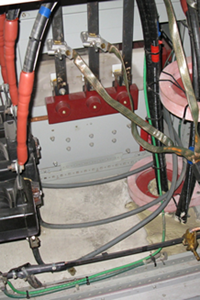Worker made contact with energized busbar
Date of incident: September 2014
Notice of incident number: 2014165370096
Employers: Electrical service company; marine terminal company
Incident summary
Four workers from an electrical service company were replacing an oil circuit breaker with a new vacuum circuit breaker inside a vault at a marine container terminal. A worker walked around to the back side of a feeder cabinet where the circuit breaker was being installed to check on some wiring. The worker inadvertently made contact with an electrical source and suffered serious injuries.
Investigation conclusions
Cause
- Electrical backfeed from the switchgear was not isolated: The worker was seriously injured because the buslinks from the reefer (refrigeration) distribution cabinets connecting energy to the vault were not removed to prevent electrical backfeed. Two rubber-tired gantry cranes were hooked up to the reefer distribution cabinets, which energized the rear feeder cabinet.
Underlying factors
- Insufficient planning: Work for the replacement of the circuit breaker was to take place primarily in the front cabinet. Both employers (the marine terminal and the electrical service company) failed to ensure that the potential for electrical backfeed was isolated from the switchgear. The work planning should have included all necessary precautions for the potential hazards associated with any work conducted in the back of the rear feeder cabinet. A worker from the marine terminal company determined that it was not necessary to remove the buslinks but failed to inform the service workers of this decision. The workers from the electrical service company ought to have assessed all of the associated work to enable them to change the oil circuit breaker. This should have included the conditions of the busbars in the rear feeder cabinet. When one of the workers left the front cabinet to check a wire in the back feeder cabinet, work should have stopped.
- Worker qualifications: WorkSafeBC guideline G19.1-2 details what a “qualified electrical worker” is. The qualifications of the workers working at the site during the incident did not meet the definition in this guideline. They were not qualified to work on equipment manufactured by a company other than their own electrical service company. The employer where the work was performed failed to ensure that the workers were qualified to work on the electrical equipment at the marine terminal.
- Lack of supervision: WorkSafeBC guideline G19.1-2 states that the electrical work can be conducted under the supervision of an individual who is authorized under the Safety Standards Act. The electrical service company failed to provide a qualified supervisor for the workers who were performing electrical work.
2021-04-22 20:42:33

